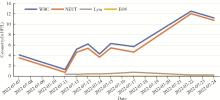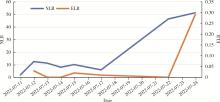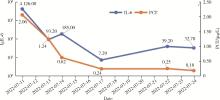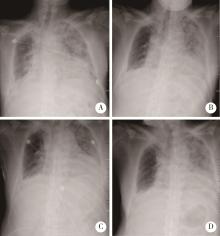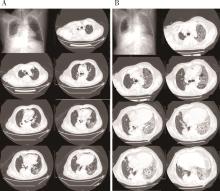北京大学学报(医学版) ›› 2024, Vol. 56 ›› Issue (5): 932-937. doi: 10.19723/j.issn.1671-167X.2024.05.029
免疫相关性重症肺炎1例
- 1. 石河子大学医学院,新疆维吾尔自治区石河子 832000
2. 克拉玛依市独山子人民医院血液肿瘤科、风湿免疫科,新疆维吾尔自治区克拉玛依 833699
Immune-related severe pneumonia: A case report
Jiajun LIU1, Guokang LIU2, Yuhu ZHU2,*( )
)
- 1. Shihezi University School of Medicine, Shihezi 832000, Xinjiang Vygur Autonomous Region, China
2. Department of Hematology, Oncology and Rheumatology, Dushanzi People's Hospital, Karamay 833699, Xinjiang Vygur Autonomous Region, China
中图分类号:
- R563.1
| 1 | 周巧, 余荷, 梁宗安. 免疫检查点抑制剂导致免疫相关性肺炎[J]. 中国呼吸与危重监护杂志, 2021, 20 (10): 753- 756. |
| 2 |
Yin JQ , Wu YJ , Yang X , et al. Checkpoint inhibitor pneumonitis induced by anti-PD-1/PD-L1 therapy in non-small-cell lung cancer: Occurrence and mechanism[J]. Front Immunol, 2022, 13, 830631.
doi: 10.3389/fimmu.2022.830631 |
| 3 |
宋博, 邬明歆, 贾英杰, 等. PD-1/PD-L1抑制剂引起免疫相关性肺炎的研究进展[J]. 国际肿瘤学杂志, 2020, 47 (10): 627- 629.
doi: 10.3760/cma.j.cn371439-20200609-00091 |
| 4 |
Fujiwara Y , Horita N , Namkoong H , et al. The effect of adding immune checkpoint inhibitors on the risk of pneumonitis for solid tumours: A meta-analysis of phase Ⅲ randomised controlled trials[J]. Eur J Cancer, 2021, 150, 168- 178.
doi: 10.1016/j.ejca.2021.03.012 |
| 5 | 韩利会, 田辉, 杨秋安. 中性粒细胞/淋巴细胞比值对晚期肺癌免疫检查点抑制剂相关性肺炎的预测价值[J]. 中国当代医药, 2022, 29 (20): 20- 25. |
| 6 | Banavasi H , Kim S , Alkassis S , et al. Immune checkpoint inhibitor-induced pneumonitis: Incidence, clinical characteristics, and outcomes[J]. Hematol Oncol Stem Cell Ther, 2023, 16 (2): 144- 150. |
| 7 | 周潇翔. 抗PD-1/PD-L1免疫治疗的不良反应谱及其预测标志物探究[D]. 北京: 北京协和医学院, 2021. |
| 8 | 免疫检查点抑制剂相关肺炎诊治专家共识[J]. 中华结核和呼吸杂志, 2019, 42(11): 820-825. |
| 9 | 王杰, 蒋士卿, 王涛. 免疫检查点抑制剂相关性肺炎的研究进展[J]. 实用临床医药杂志, 2022, 26 (10): 135-138, 143. |
| 10 | 代丽源, 石远凯, 韩晓红. 免疫检查点抑制剂治疗晚期非小细胞肺癌的预后标志物动态监测研究进展[J]. 协和医学杂志, 2022, 13 (2): 287- 295. |
| 11 |
赵喆, 唐彦, 朱惠娟, 等. 免疫检查点抑制剂引发的免疫相关不良反应研究进展[J]. 临床药物治疗杂志, 2022, 20 (6): 1- 6.
doi: 10.3969/j.issn.1672-3384.2022.06.001 |
| 12 |
Thomas R , Sebastian B , George T , et al. A review of the imaging manifestations of immune check point inhibitor toxicities[J]. Clin Imaging, 2020, 64, 70- 79.
doi: 10.1016/j.clinimag.2020.04.007 |
| 13 | 李彩丽, 翟沙, 张静, 等. 感染性休克外周血单核细胞TLR4/MyD88/NF-κB p65信号通路表达[J]. 中华医院感染学杂志, 2022, 32 (13): 1931- 1935. |
| 14 | 曹蒙, 王涛. 凝血功能、炎性因子和细胞免疫功能在感染性休克患者中的检测意义[J]. 血栓与止血学, 2022, 28 (2): 260- 261. |
| 15 | 王威, 张迎庆. 去甲肾上腺素急救治疗脓毒症休克的临床效果及其对炎性因子的影响研究[J]. 北方药学, 2021, 18 (10): 38- 39. |
| 16 | 马丽云, 闫春良, 赵秋红, 等. 免疫检查点抑制剂治疗非小细胞肺癌引起相关肺炎的临床分析[J]. 癌症进展, 2021, 19 (8): 810- 813. |
| 17 | Wang HP , Guo XX , Zhou JX , et al. Clinical diagnosis and treatment of immune checkpoint inhibitor-associated pneumonitis[J]. Thorac Cancer, 2020, 11 (1): 191- 197. |
| 18 | 中国临床肿瘤学会指南工作委员会作. 中国临床肿瘤学会(CSCO)免疫检查点抑制剂相关的毒性管理指南2021[M]. 北京: 人民卫生出版社, 2021: 4. |
| 19 | Henderson Berg MH , Del Rincón SV , Miller WH . Potential therapies for immune-related adverse events associated with immune checkpoint inhibition: From monoclonal antibodies to kinase inhibition[J]. J Immunother Cancer, 2022, 10 (1): e003551. |
| [1] | 杨朵,周心娜,王硕,王小利,袁艳华,杨化兵,耿会珍,彭兵,李子博,李彬,任军. 树突状细胞疫苗特异肿瘤多肽联合树突状细胞体外刺激淋巴细胞功能评估[J]. 北京大学学报(医学版), 2021, 53(6): 1094-1098. |
| [2] | 蒋青,张雨. 新形势下运动损伤特点及细胞生物治疗的应用前景和挑战[J]. 北京大学学报(医学版), 2021, 53(5): 828-831. |
| [3] | 朱红林,杜倩,谌威霖,左晓霞,李全贞,刘思佳. 系统性硬化症血清细胞因子表达谱变化及调控机制[J]. 北京大学学报(医学版), 2019, 51(4): 716-722. |
| [4] | 刘佳兴,胡贵平,赵琳,张永明,王丽,贾光,刘瑞祥,冯慧敏,徐华东. 铬酸盐低水平长期职业接触与劳动者早期健康效应[J]. 北京大学学报(医学版), 2019, 51(2): 307-314. |
| [5] | 刘颖君,欧阳翔英,王宇光,吕培军,安娜. 生长停滞特异性蛋白6在牙龈卟啉单胞菌脂多糖诱导内皮细胞黏附因子及趋化因子表达中的作用[J]. 北京大学学报(医学版), 2018, 50(1): 20-25. |
| [6] | 窦晶莉,白力,庞春艳,张文兰,张伟,王永福. 脂肪间充质干细胞对博来霉素诱导的硬皮病小鼠模型的治疗作用[J]. 北京大学学报(医学版), 2016, 48(6): 970-976. |
| [7] | 安乐美,李娟,季兰岚,李光韬,张卓莉. 类风湿关节炎患者外周血滤泡辅助性T细胞水平检测[J]. 北京大学学报(医学版), 2016, 48(6): 951-957. |
| [8] | 王志华,张伟,张艳清,庞春艳,王永福. CD40 siRNA对 MRL/Lpr狼疮小鼠炎症反应的影响[J]. 北京大学学报(医学版), 2016, 48(5): 771-776. |
| [9] | 李昊, 张幼怡. 促炎细胞因子在交感/儿茶酚胺介导心脏重塑中的作用[J]. 北京大学学报(医学版), 2014, 46(6): 1001-1004. |
| [10] | 王恩博, 崔念晖, 柴原孝彦, 野村武史, 张伟, 俞光岩. 牙源性角化囊性瘤骨吸收相关因子组织化学及免疫组织化学双重染色表达[J]. 北京大学学报(医学版), 2010, 42(1): 85-89. |
| [11] | Jian-wei GU, Emily YOUNG, Zhi-jun PAN, Kevan B. TUCKER, Megan SHPARAGO, Min HUANG, Amelia Purser BAILEY. SD大鼠长期高盐饮食可导致其高血压并改变肾细胞因子基因表达谱[J]. 北京大学学报(医学版), 2009, 41(5): 505-515. |
| [12] | 常英军, 黄晓军. 细胞因子在造血干细胞移植中诱导免疫耐受的基础和应用研究[J]. 北京大学学报(医学版), 2009, 41(2): 208-211. |
| [13] | 崔念晖, 张伟, 王恩博, 魏明洁, 郭传瑸, 俞光岩. 口腔鳞状细胞癌侵犯颌骨与破骨细胞及相关细胞因子的关系[J]. 北京大学学报(医学版), 2007, 39(1): 30-32. |
| [14] | 孙晓云, 苏茵, 任丽敏, 韩蕾, 栗占国. 甲氨蝶呤对类风湿关节炎患者的治疗作用及对相关细胞因子的影响[J]. 北京大学学报(医学版), 2006, 38(4): 356-359. |
| [15] | 钱晓萍, 李国栋, 韩克军, 陈慰峰. 白细胞介素-6参与肿瘤相关抗原HCA520对HEK293细胞的促增殖作用[J]. 北京大学学报(医学版), 2005, 37(3): 310-313. |
|
||
